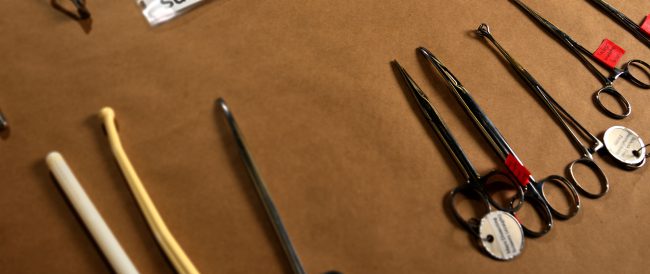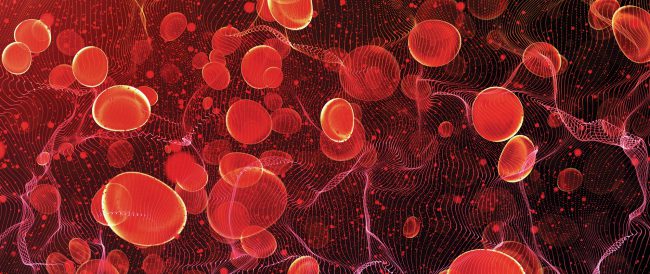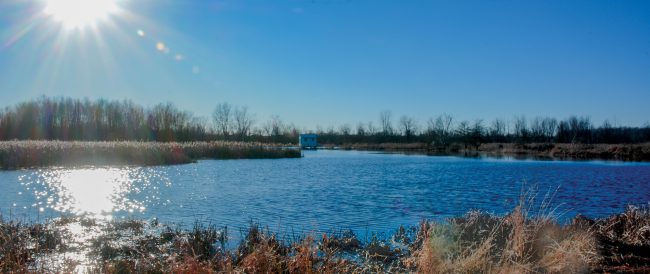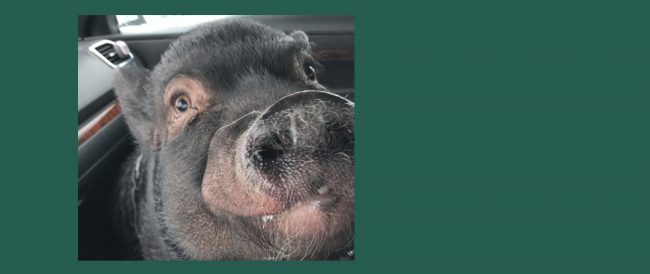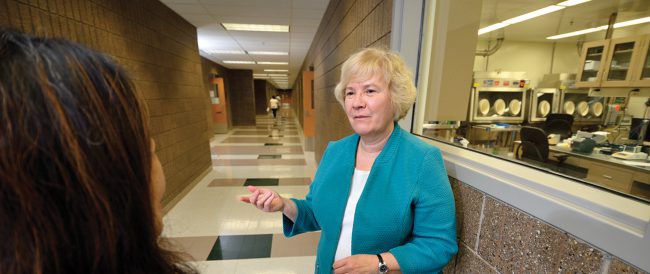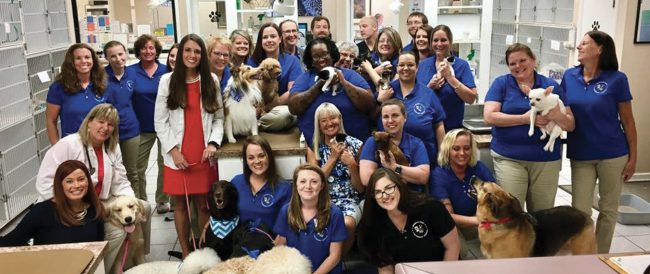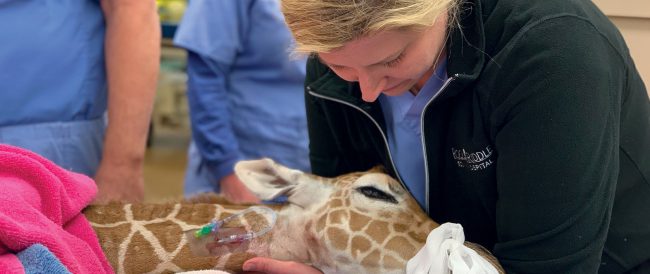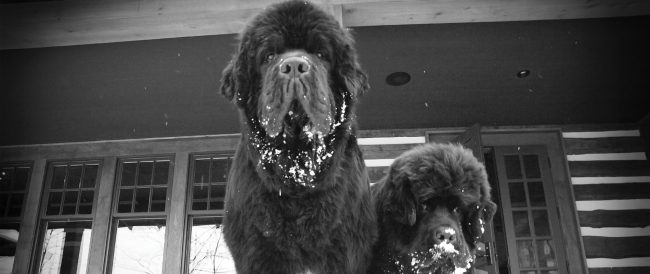 Read More
Read More

While many of us exchanged candy and cards on Valentine’s Day, Stella, a two-year-old, female Rottweiler, fought for her life. What was meant to be a night complete with heart-shaped bones and extra kisses from her owners ended up filled with smoke, firefighters, and an oxygen mask.
On the evening of February 14, 2019, Stella was rescued from a house fire by the Lansing Fire Department. They brought her to the Michigan State University Veterinary Medical Center’s Emergency and Critical Care Medicine Service (ECCM).
Stella was in critical condition. Her diagnoses included smoke inhalation, pneumonia, ulcers, scars in her eyes, and second- and third-degree burns that covered 10 percent of her body—head, nose, ears, and hind end; worst of all were the burns on the left side of her body. The ECCM team identified the trauma and extensive injuries to Stella’s trachea and lungs as the predominant threat to Stella’s survival. She was immediately put on intravenous fluids and pure oxygen and placed in a highly oxygenated cage to help her breathe.
For two weeks, she fought for her life. “Stella’s will to live was amazing; she never gave up or quit fighting,” says Rose Wahl, licensed veterinary technician for the ECCM. “Stella is one of the bravest and strongest patients I’ve ever encountered.”
Stella's Hero: How a Special Donor and Fish Helped Heal Stella
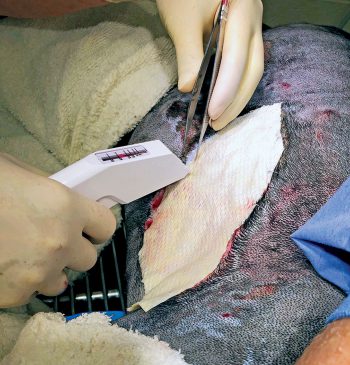
Once Stella was stabilized by the MSU ECCM, the MSU Soft Tissue Surgery Service tackled her burns, while the Comparative Ophthalmology Service treated her eye injuries. “We had to get creative to treat Stella’s burns. There was significant trauma to her lungs, which took priority. She wasn’t a great candidate to sedate heavily or anesthetize,” says Dr. Brea Sandness, surgical resident at the MSU College of Veterinary Medicine.
That’s when Sandness and Anna-Marie Struble, a fourth-year DVM student on a clinical rotation with the Soft Tissue Surgery Service, discovered a less traditional method to treat Stella’s burns—descaled acellular Icelandic cod skin grafts. The grafts, which were produced and manufactured by Kerecis of Isafjordur, Iceland, were donated by Kerecis and shipped to MSU immediately.
Typically, with large, surface-area wounds, surgeons use free tissue grafts, local flaps, tissue expanders, primary closure, or other potentially regenerative techniques. These techniques, however, can involve substantial donor-site morbidity and prolonged operative time, all of which can increase the hospital stay and costs associated with care. “With these grafts, we needed only minimal sedation for placement, so we could start the healing process without putting her fragile lungs, or other areas of her body, under additional stress,” says Sandness.

The Kerecis Omega3 fish skin product line has been approved for use in humans and has treated human burn wounds in the United States and Europe, but had not been applied in veterinary patients until now. Stella’s case was the first usage of Kerecis Omega3 in a veterinary setting in the world.
“Burn injuries present unique challenges that slow wound healing and cause inflammation, bacterial infection, pain, and scarring,” says Sandness. “The rapid contraction and scarring process that occurs as burn wounds heal can leave patients like her with limited functionality and increased risk of inflammation and infection, which could endanger the life of the patient. A burn wound treatment that creates a barrier to infections and enhances the body’s response to healing was essential to reduce her risk of mortality.”
The fish skin covers the exposed wound and protects it from bacteria and the environment. It also limits heat and water loss, which can be critical in treating large burns. One key benefit of using a biologic product that integrates into the wound is that there is less need for dressing changes, which can be particularly painful when the dressing sticks to the wound. The risk of infection in burns can otherwise require daily dressing changes, which put the patient through repeated trauma that can be avoided with the fish skin.
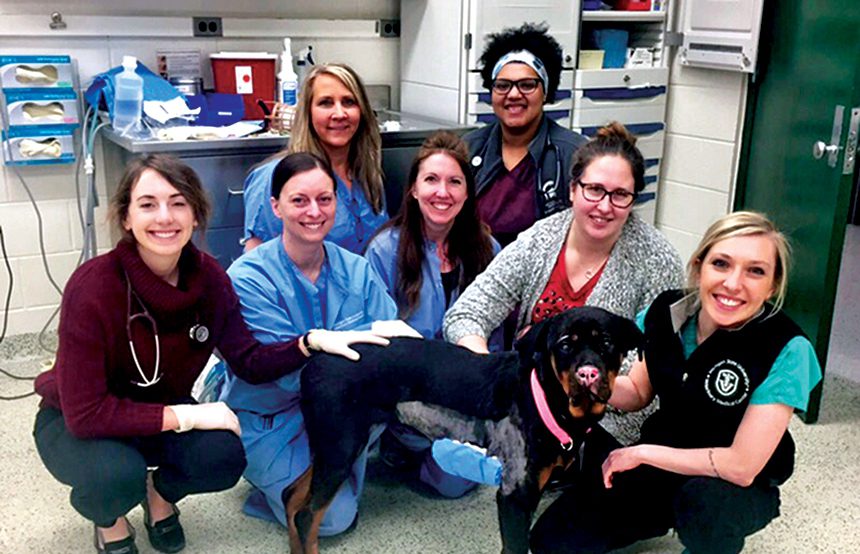

“It’s incredible how a company half a world away would step in to help a family they didn’t know,” says Sandness. “Their generosity and genuine care for Stella and her family are great reminders of how good humanity can be.”
Together, Kerecis and MSU’s Veterinary Medical Center have opened the door in the veterinary medical profession for additional patients to benefit from these fish skin grafts. Since March, when the fish skins were first used on Stella, many more patients have benefitted from them all over the world. These patients have been animals such as dogs, cats, and even a turkey. “Stella’s case has been an inspiration. The use of these grafts has opened the podium for discussion on the use of fish grafts, specifically these grafts, in the veterinary medical field,” says Sandness. Each case has allowed for collaboration of veterinarians all over the world, which has allowed for better care and treatment.
Fish Skins for Burn Wounds—How and Why They Work
In using a fish-based graft, there is no risk of disease transmission from fish to human or other animals, unlike when pig- or cow-based grafts are used. The acellular fish skin graft allows for a more naturally intact product and offers special benefits, such as tension resistance, moisture protection and durability, different collagen types, and enhanced presence of omega-3 fatty acids in cells. This type of fish skin graft also allows for more rapid cell reproduction and blood vessel generation, both of which are key components of the healing process.
The cod, which are wild and found in cold water, offer skin grafts that have a low level of bacteria, no risk of viral transfer, and high omega-3 fatty acid content. The cod is gently processed, which preserves its natural features; this way, the skins retain more natural healing power and a structure that is similar to human skin in form and function.
After grafting, the cod skin recruits the body’s own cells and, ultimately, is converted into living tissue. This ingrowth of cells is the fundamental first step in tissue regeneration. These acellular grafts are reapplied as needed during the healing process. The fish skin grafts, which are FDA approved, are available in multiple countries, and are covered by Medicare and other insurances.
Scaly and Smiley: Stella’s New Normal

At MSU, Stella ignited a fire within all the Hospital’s clinicians, technicians, and students who worked with her. Her wagging tail and fierce determination spread like wildfire and fueled the Hospital’s flame to not only heal her, but to innovate a new solution that would heal Stella in the most effective and least painful way possible.
“It’s through the teamwork and collaboration of the Hospital’s technicians, students, and Emergency and Critical Care, Soft Tissue Surgery, and Comparative Ophthalmology Services that we were able to expand upon our knowledge and treat Stella’s lungs, eyes, and skin wounds in the best possible way,” says Sandness. “This is the first time this type of graft has been applied to any animal and so it is considered a novel technique. MSU is always looking for the newest and potentially revolutionary techniques in every department. I’m honored to be a part of this Hospital, University, and surgical team.”
Stella’s owners, who have been doing whatever it takes to make Stella comfortable and heal her wounds, regularly check-in with the Hospital’s Soft Tissue Surgery Service. And even though the house fire greatly altered their lives, they are happy that their family is together. “We would like to thank you all for going above and beyond to make sure Stella was always as comfortable as possible and for being so understanding,” says Mrs. Darmer, Stella’s owner. “Sometimes, it takes a tragic event to realize how blessed we are.”

Spartan Story: An Unwavering Passion for Veterinary Surgery—and Saving Four-Legged Lives
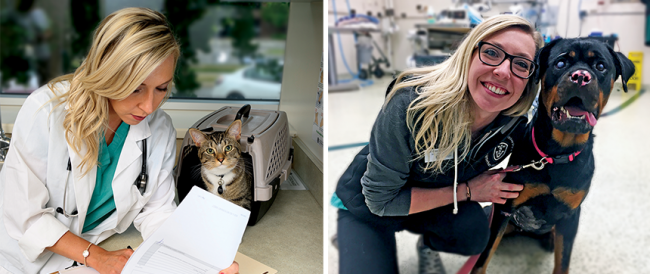
Dr. Brea Sandness didn’t always know she wanted to be a veterinarian. “It was a gradual realization, I guess. I’ve loved animals for as long as I can remember, and my family always called me the animal whisperer, but it wasn’t something I immediately knew I wanted to do, unlike many of my classmates,” says Sandness. What she always knew about herself was that she loved medicine, studying the anatomy of things like deer (she is from a hunting family) and frogs (from her high school anatomy class), and healing animals and people. “It was halfway through my undergraduate studies that I realized I could combine all of the things I loved into one occupation: veterinary medicine. From that moment on, it was where I focused my studies.”
Her childhood dog, Klay, is the reason why she wants to specialize in veterinary surgery. “He sustained a shoulder injury while hunting, and our family veterinarian wasn’t able to treat it. I grew up in North Dakota, where there were no veterinary surgery specialists in the entire state. In fact, there still aren’t any. So, we would’ve had to take him to the University of Minnesota in order for him to receive the recommended surgery from the specialists; that was not realistic for us financially. Though he lived a great life, I wish our family would have had the opportunity to provide him with the gold standard of care, as well as a better quality of life, like we do here at MSU,” says Sandness. “My long-term goal following my residency is to move back to North Dakota; I want to be the first surgical specialist in the state. That way, I can provide specialty care to the animals and their families, care that we didn’t have for my pets.”
As a first-year resident for the MSU Veterinary Medical Center, Sandness is passionate about many facets in the surgical field including orthopedic and soft tissue surgery. These include fracture repair, minimally invasive procedures, wound management, and reconstructive surgeries. She has been studying, researching, and practicing veterinary surgery since she completed her DVM at the Oregon State University College of Veterinary Medicine in 2015. Sandness has completed one rotating medical and surgical internship and three specialty surgical internships, the last of which she completed at MSU in June of 2019. This specialty is not just something she feels that she has to pursue; it is something she feels she is meant to do.
For Sandness, these specialty areas of medicine are personal. “My dad was severely burned in a house fire. Though I was young throughout his recovery, I remember some of the hospital visits, surgeries, and check-ups. I was able to see first-hand the effects his doctors, nurses, and rehabilitation specialists had on making his life as good and painless as possible,” says Sandness. Though her dad had to learn new ways of doing things, he does not let his burns or what happened define him. “Being able to apply that to my field, in veterinary medicine, is so important. I want these animals to return to as normal of a life as possible. No, these animals don’t go on to have jobs, but we can help heal them so they can be functional, happy animals that live their best and most comfortable lives,” says Sandness.
The gratification that comes from being able to heal something that was once broken, malfunctioning, or inhibiting is a reason why surgery has always been so attractive to Sandness. “I love working with and helping animals and families, especially those like Stella,” she says. “I think that is part of the glory of surgery—that I have this ability to heal something with my hands. I get to tell animal owners I can potentially heal their pets or give them a better quality of life than they currently have and it’s one of the best feelings there is.”
The collaborative element of surgery is what Sandness loves most about this specialty. From reconstructive surgeries in cancer patients, assisting with neurosurgeries, and fixing broken bones, to healing burn wounds with fish skins, veterinary specialists in different departments who work together are able to provide animals with a longer average lifespan. “When we work together, there isn’t much we can’t do,” says Sandness.
Though veterinary medicine and surgery offers Sandness a great deal of rewards, it also presents a number of challenges. “There are lots of really good days, but there also are bad days; it’s okay to cry and be sad with owners. It shows empathy, and it means a lot that you are able to be there to help them while they struggle through the pain, and sometimes loss,” says Sandness.
Since Sandness is in a teaching setting at MSU, she is challenged with not only growing as a surgery resident herself and handling loss and struggle, but also educating future veterinary professionals on how to do the same. “The students make me a better surgeon. They stand there, bright-eyed and bushy-tailed, at 2:00 a.m. when I’m performing emergency surgery. They’re just so eager to take in and learn everything. Though those long nights—and the losses—are difficult, the students bring so much energy, enthusiasm, and passion to every situation they’re in. I truly value and admire that.”
Support also has been a big part of Sandness’ career, as it has allowed her to pursue her specialty. She has three cats at home (Pheobe, Blitzen, and Stout), a husband, friends, and family, all of whom have been integral in mentoring, supporting, and encouraging her.
While the support has been important, the passion Sandness has for her work is the main driver of her determination to succeed, ambition to learn, and dedication to animal health. “I think if you have that passion, and you are able to keep it, then you can do anything; it’s what keeps the hard days from being harder and it’s what makes the good days so good,” says Sandness. “I was never the person with the highest GPA, and veterinary surgery is a difficult profession to break into. So, I had to work really hard; it took me a lot longer to get to where I wanted to be—here at MSU—but I thought, what’s the difference from a-to-b if I make some pitstops along the way? Those pitstops are what have shaped me as a person, friend, wife, doctor, and as a surgeon.”
“I think if you have that passion, and you are able to keep it, then you can do anything; it’s what keeps the hard days from being harder and it’s what makes the good days so good.”
— Dr. Brea Sandness


